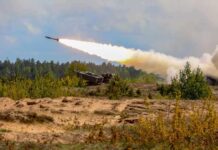President Trump redirects critical anti-drone technology from Ukraine to U.S. troops in the Middle East, signaling a decisive shift in America’s military priorities and commitment to its own forces.
Key Takeaways
- The Trump administration is diverting specialized anti-drone fuzes originally purchased for Ukraine to protect U.S. troops in the Middle East against Iranian and Houthi threats.
- Defense Secretary Pete Hegseth identified this redirection as an “urgent issue” in communications with Congress, prioritizing American military needs.
- Russia has intensified drone attacks on Ukraine, launching over 20,000 drones since 2025, with Ukrainian intelligence predicting deployments of 500+ long-range drones per night.
- President Trump recently told Putin that Russia “will have to respond” to Ukraine’s drone attacks on Russian military airfields, suggesting a cooling of U.S. support for Ukrainian offensive actions.
- No new aid packages for Ukraine have been approved since Trump began his second term, marking a significant policy shift from the previous administration.
America First: Protecting U.S. Troops Takes Priority
The Trump administration has made the strategic decision to redirect anti-drone technology initially earmarked for Ukraine to American forces stationed in the Middle East. This technology, specifically special fuzes used in ground-to-air rocket systems designed to protect against drone attacks, was originally purchased for Ukraine by the Biden administration. The Pentagon has informed Congress of this redirection, with Defense Secretary Pete Hegseth designating it as an “urgent issue” in response to growing threats from Iran and Houthi militants in Yemen.
“U.S. President Donald Trump’s administration is redirecting anti-drone technology earmarked for Ukraine to its own troops based in the Middle East, the Wall Street Journal (WSJ) reported on June 4,” Wall Street Journal
This policy shift represents a clear implementation of President Trump’s America First doctrine, prioritizing the protection of U.S. military personnel facing immediate threats in the Middle East over continued technological support for Ukraine. The decision aligns with the administration’s broader strategy of reassessing foreign military commitments while strengthening America’s defensive posture in regions where U.S. forces are directly engaged.
Ukraine’s Growing Drone Challenge
While the Trump administration redirects resources to protect American troops, Ukraine continues to face escalating drone attacks from Russia. President Zelenskyy has reported that Russia has launched over 20,000 drones toward Ukraine since 2025, with a particularly significant attack involving 472 drones occurring on June 1. Ukrainian military intelligence suggests an even more concerning trend, predicting that Russia will soon deploy more than 500 long-range drones per night against Ukrainian targets.
Ukraine has been urging its partners to invest in arms production and provide additional air defense systems, particularly Patriot systems, to counter these intensifying Russian attacks. However, this request comes at a time when the Trump administration has shown increased skepticism toward providing additional military aid to Ukraine, with no new aid packages approved since the beginning of Trump’s second term.
Trump’s Shifting Ukraine Policy
President Trump’s approach to the Ukraine conflict shows a marked departure from the previous administration’s policies. Military aid to Ukraine was temporarily halted in March but resumed after discussions about a potential truce plan. Defense Secretary Hegseth, who has been notably critical of additional aid to Ukraine, did not attend a recent Ukraine Defense Contact Group meeting, further signaling the administration’s shifting priorities.
“Following a call on June 4 with Russian President Vladimir Putin, Trump said that Putin ‘will have to respond’ to Ukraine’s recent drone attack on military airfields,” Trump
The President’s recent phone call with Russian President Vladimir Putin further illustrates this policy evolution. Trump acknowledged that Russia “will have to respond” to Ukraine’s drone attacks on Russian military airfields, suggesting a more balanced approach to the conflict rather than unconditional support for Ukrainian military actions. This stance reflects the administration’s focus on pursuing diplomatic solutions and avoiding further escalation of the conflict while protecting America’s core interests.
Regional Implications and Strategic Realignment
The redirection of anti-drone technology represents more than just a tactical decision; it signals a broader strategic realignment in U.S. foreign policy. By prioritizing the protection of American forces in the Middle East over continued technological support for Ukraine, the Trump administration is demonstrating its commitment to addressing immediate threats to U.S. personnel and interests. This policy shift acknowledges the complex realities of multiple global conflicts and the necessity of allocating limited resources according to American priorities.
The decision also reflects a recognition that the nature of modern warfare continues to evolve, with drone technology playing an increasingly central role in conflicts around the world. As both Ukraine and U.S. forces in the Middle East face drone threats, the administration has calculated that American troops facing potential Iranian and Houthi attacks require these defensive capabilities more urgently than Ukraine, where alternative defense arrangements might be possible through European partners.











